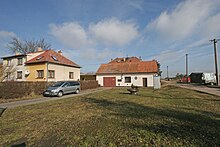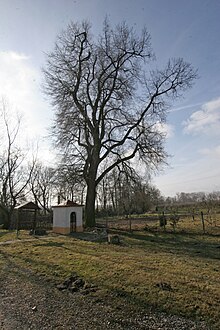Podůlšany
| Podůlšany | ||||
|---|---|---|---|---|
|
||||
| Basic data | ||||
| State : |
|
|||
| Region : | Pardubický kraj | |||
| District : | Pardubice | |||
| Area : | 334 ha | |||
| Geographic location : | 50 ° 8 ' N , 15 ° 44' E | |||
| Height: | 227 m nm | |||
| Residents : | 169 (Jan. 1, 2019) | |||
| Postal code : | 533 45 | |||
| License plate : | E. | |||
| traffic | ||||
| Street: | Hradec Králové - Lázně Bohdaneč | |||
| structure | ||||
| Status: | local community | |||
| Districts: | 1 | |||
| administration | ||||
| Mayor : | Vladimír Čapský (as of 2019) | |||
| Address: | Podůlšany 42 533 45 Opatovice nad Labem |
|||
| Municipality number: | 572951 | |||
| Website : | www.podulsany.cz | |||
Podůlšany ( German Podulschan ) is a municipality in the Czech Republic . It is located eleven kilometers southwest of the city center of Hradec Králové and belongs to the Okres Pardubice .
geography
Podůlšany is located in the Pardubická kotlina ( Pardubice Basin ) on the Opatowice Canal . State road II / 333 runs on the western outskirts between Hradec Králové and Lázně Bohdaneč , two kilometers north of Dálnice 35 . To the east is the Opatovice power plant.
Neighboring towns are Sedlice , Praskačka and Libišany in the north, Liščí, Pohřebačka and Opatovice nad Labem in the Northeast, Čeperka , Bukovina nad Labem and Zástava the east, Dříteč , Hrobický Dvůr, Hrobice Mala Čeperka and Srch in the southeast, Stéblová , Ždánický Dvůr and Nové Ždánice in the south, Staré Ždánice in the southwest, Plch in the west and Osice , Polizy and Krásnice in the northwest.
history
Podolsani was first mentioned in writing in the ratification document issued between 1142 and 1148 and confirmed by Duke Vladislav II and Bishops Otto and Heinrich Zdik on the founding of the Cistercian Monastery of Sedletz by Prince Miroslav, who left the village and its accessories to the monastery. Later the village belonged to the possessions of the Benedictine monastery Opatowitz . After the monastery was plundered and burned down by a Hussite army under Diviš Bořek von Miletínek in 1421 , the latter took possession of the extensive possessions. In 1436 King Sigismund transferred large parts of the former monastery property to Diviš Bořek, who formed the Pardubice dominion with its seat on the Kunburg . In 1437 Diviš 'son Soběslav Mrzák of Miletínek inherited the rule, in 1464 it fell to King George of Podebrady . On April 5, 1465, he transferred the rule to his sons Viktorin , Heinrich d. Ä. and Hynek von Münsterberg . In 1472 the rule of Pardubitz fell to Heinrich d. Ä. from Munsterberg to; he sold it in 1490 to Wilhelm von Pernstein , who had the Pardubice Castle built as a new seat. Wilhelm von Pernstein had numerous fish ponds built and, after purchasing a piece of land on the Elbe near Opatowitz in 1513, dug the new Opatowitz Canal, which replaced the Velká Strouha as the main water supply to his ponds. In 1521 he bequeathed his Bohemian goods to his younger son Vojtěch , after his death in 1534 they passed to his brother Johann . In 1548 he left his son Jaroslav in high debt. On March 21, 1560 Jaroslav von Pernstein sold the entire rule of Pardubitz to King Ferdinand I. His successor Maximilian II transferred the administration of the royal lords to the court chamber . At the beginning of the 17th century, a well-to-do free crowd had a large, dedicated to St. Build a wooden chapel consecrated to Nicholas, which was more spacious than the churches in Wositz and Zdanitz and endowed it richly. The descendants of the founder received a family crypt in the chapel, which was first mentioned in writing in 1665.
In 1835 the village Podulschan or Podwolssany , located in the Chrudim district on the road leading from Přelautsch to Königgrätz , consisted of 26 houses in which 233 people lived. In the place there was a public one dedicated to St. Chapel dedicated to Nicholas, where services were held for the residents of the village. The three bells in the tower of the chapel bore the dates 1629 and 1708. The owners of the Freisassenhof, which was dismantled at the beginning of the 19th century, shared the funeral rights in the chapel. The parish was Wositz. Until the middle of the 19th century, Podulschan remained subject to the Imperial and Royal Chamber of Commerce Pardubice.
After the abolition of patrimonial Podolšany formed a municipality in the judicial district of Pardubice from 1849 . From 1868 the community belonged to the Pardubitz district . In 1869 Podolšany had 288 inhabitants and consisted of 26 houses. The place name Podůlšany has been used since the end of the 19th century . In 1894 the chapel was dismantled and transported to Prague , where it was rebuilt in 1895 as an exhibit in the Czechoslovak Ethnographic Exhibition . In 1900 there were 292 people in the village, compared to 260 in 1910. Between 1900 and 1904, as decided in 1894, the construction of a stone church took place, the construction costs of 23,380 kroner were partly covered by a loan. The first negotiations to build a road to Čeperka took place in 1919. Initially, however, only the section of road between the two bridges over the Opatowitz Canal behind the village, located on the Podůlšan district, was constructed and the lower of the two bridges was renewed. The municipality was electrified in 1923, and the first considerations were made in 1912. In 1930 Podůlšany had 299 inhabitants. The new syringe house and municipal office was built in 1935. In 1949 Podůlšany was assigned to the Okres Pardubice-okolí, since 1960 the municipality has belonged again to the Okres Pardubice . On April 30, 1976 Podůlšany was incorporated into Staré Ždánice ; since November 24, 1990 the parish has existed again. In the 2001 census, 151 people lived in the 53 houses in Podůlšany.
Attractions
- Church of St. Nikolaus, the neo-renaissance building erected on the site of the wooden chapel that was demolished in 1894 for the Czechoslovak Ethnographic Exhibition in Prague was built between 1900 and 1903 by the builder Hoch from Praskačka according to plans by the architect Franz Schmoranz the Elder, revised by Čeněk Křička. Ä. built. The organ was created in 1902 by Antonín Mölzer from Kutná Hora . The consecration took place in 1904.
- Opatowice Canal
- Chapel under a mighty linden tree northeast of the church on the state road
- Statue of St. Wenceslaus, next to the chapel
- Niche chapel, opposite the church at the junction of the road to Staré Ždánice
literature
- Historický lexikon obcí České republiky 1869–2005 , part 1, p. 526
Web links
Individual evidence
- ↑ http://www.uir.cz/obec/572951/Podulsany
- ↑ Český statistický úřad - The population of the Czech municipalities as of January 1, 2019 (PDF; 7.4 MiB)
- ^ Johann Gottfried Sommer , Franz Xaver Maximilian Zippe: The Kingdom of Böhmen. Represented statistically and topographically. Volume 5: Chrudimer Kreis. Prague 1837, p. 68.
- ↑ Description of the church on hrady.cz




